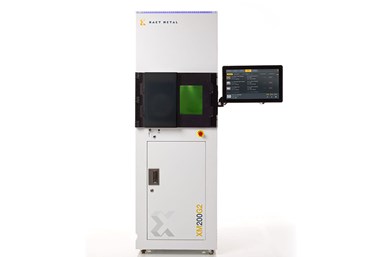Xact Metal XM200G Printers Feature Configurable Single-or Dual-Laser Systems
The XM200G family of printers is designed to offer highly configurable, affordable metal 3D printing performance.
Share
Read Next

The metal printers feature configurable single- or dual-laser systems.
Xact Metal’s XM200G printer series is designed to offer affordable metal 3D printing to small- to medium-sized companies. The printers are powered by high-performance galvanometer mirrors to meet the specification demands of metal powder-bed fusion (SLM/DMLS) in manufacturing, research and development, and other additive manufacturing (AM) applications where print speed, part quality and affordable price are essential.
The XM200G line is well suited for printing parts where high-performance applications and print speed are critical, the company says. The metal printers feature configurable single- or dual-laser systems that are said to provide industrial speed and performance at an affordable price, enabling a wide variety of customers to benefit from metal laser powder-bed fusion (LPBF) technology.
According to the company, the XM200G line is based on the proven, easy-to-use and cost-effective design of the Xact Metal XM200C metal 3D printer, but instead integrates a high-performance galvanometer system to move the laser beam over the powder bed. This architecture is said to enable faster printing times and the ability to support multiple lasers.
To increase print speeds, the XM200G provides the option of using two lasers at one time with either a 100% overlapping work area (100 𝜇m spot size) or a 66% overlapping work area (50 𝜇m spot size). With a 150 × 150 × 150 mm build volume, the XM200G is configurable to match different applications, including options for a 100, 200 or 400 W fiber laser, a water-cooled galvanometer and a glovebox to ease powder handling with an integrated powder-handling system.
The XM200G printers were developed for use in a variety of metal 3D printing applications, including product development, tooling manufacturing, metal powder-bed research and education.
Related Content
-
How Norsk Titanium Is Scaling Up AM Production — and Employment — in New York State
New opportunities for part production via the company’s forging-like additive process are coming from the aerospace industry as well as a different sector, the semiconductor industry.
-
3D Printing Molds With Metal Paste: The Mantle Process Explained (Video)
Metal paste is the starting point for a process using 3D printing, CNC shaping and sintering to deliver precise H13 or P20 steel tooling for plastics injection molding. Peter Zelinski talks through the steps of the process in this video filmed with Mantle equipment.
-
Beehive Industries Is Going Big on Small-Scale Engines Made Through Additive Manufacturing
Backed by decades of experience in both aviation and additive, the company is now laser-focused on a single goal: developing, proving and scaling production of engines providing 5,000 lbs of thrust or less.













